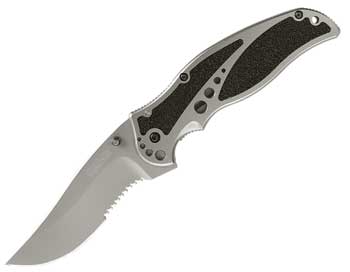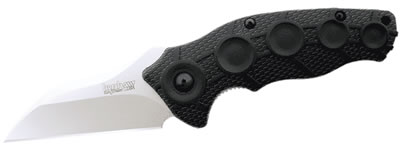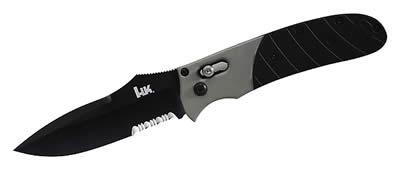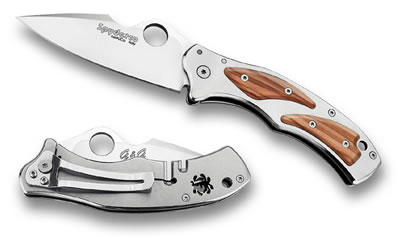A recent conversation on
David W. Boles's thought-provoking blog, Urban Semiotic — which you should be reading daily, if you aren't already — reminded me that I haven't written much here about my blade obsession.
Let's remedy that omission, starting now.
As far back as I can remember, I've been fascinated — some might say
morbidly fascinated — by sharp-bladed objects. (The Freudians among you can make of that what you will.) One of my few nostalgic possessions from my childhood is a wicked-looking hunting knife in a leather sheath — a relic of my Cub Scout days some 35 years ago. Being the consummate indoorsman that I am, I despised camping — not to mention pretty much everything else that went along with Scouting — but I loved having an excuse to pack around a big honking bowie knife.
Throughout most of my youth, I carried in my pocket a Swiss Army knife of one make or another. My knives were always of inexpensive manufacture, given that I was then as I am now, an inattentive sort prone to misplacing things. And it wasn't that I was handy or craftsmanlike in any way, shape, or form. I have little interest in carpentry or other tool-intensive vocations, plus I possess the manual dexterity of a punch-drunk fighter wearing boxing gloves. I just liked fiddling with the knife.
When I went off to college, I stopped toting a knife around for a couple of reasons: (1) a Swiss Army knife made an uncomfortable lump in the front pocket of the snug-fitting jeans we were wearing so fashionably in those halcyon times; and (2) my fellow dormitory residents displayed a shocking propensity for cutlery theft. (I can admit this now that the statute of limitations has elapsed: I lost to someone's pilfering fingers a couple of sweet switchblades that... well... someone smuggled across the border from Tijuana, in addition to my SAK.)
Having broken the pocket-carry habit, I meandered through my young adult years content to stash my Swiss in my briefcase. Only occasionally — on package-opening holidays, for instance — did I return it to its rightful place in my trousers. Over the years, I indulged my jones for steel more furtively, casting occasional longing glances into the window of the cutlery shop in the local shopping mall — whose proprietors surely wearied of wiping my nose prints off their glass.
Then, as serendipity would have it, I found myself one day browsing the sporting goods department of a certain discount megastore. Like an asteroid captured by the gravity of Jupiter, I was pulled inexorably toward the knife counter. I wiped drool from my chin as I stared slack-jawed and glassy-eyed at the photographs of the cutlery specimens available for sale. One knife in particular caught my eye — a sleek, curvaceous vision in stainless steel.
Summoning my courage, I asked the GED recipient behind the counter if I might see an example up close. After a prolonged period of fumbling with keys and burrowing through boxes, the clerk placed into my sweaty, trembling palm the object of my desire:

And that cold steel monkey climbed onto my back once again.
The blade that launched a dozen subsequent purchases is still one of my favorite EDC (everyday carry, in knife-speak) pieces. The Kershaw Model 1475ST —
aka the Storm II (the just-plain-Storm looks identical, but is smaller) — is made in the good old U.S. of A. (Tualatin, Oregon, to be precise) by
Kershaw Knives, an American subdivision of Kai Corporation, the well-respected Japanese cutlery manfacturer. The Storm's sweeping reverse-curve silhouette and sequential decorative holes reflect the signature styling of Hawaii-based
Ken Onion, knifemaker to the stars (Onion has created custom blades for such celebrities as Nicolas Cage and Aaron Neville) and one of Kershaw's leading affiliated designers.
My Storm fits my chubby fist as though molded to my grip. Its razor-sharp blade (trust me on this!) is crafted from Sandvik 13C26 stainless steel, while its scales (the bilateral handle components) are hefty 410 stainless with sandpaper-like inlays for secure handling. It opens smoothly via either a thumb stud or index-finger flipper, locks its sturdy blade into place with a satisfying
ka-chunk, and cuts like nobody's business. Thanks to its flat profile, it rides my pocket so inobtrusively that I can easily forget that I'm carrying it.
Plus, it shares its name with
one of my favorite superheroines. How cool is that?
I'll share other items from my blade drawer in future "What's In My Pocket?" posts. Right now, I feel the need to cut something.
Labels: Cool Stuff, Sharp Objects, Whats In My Pocket













